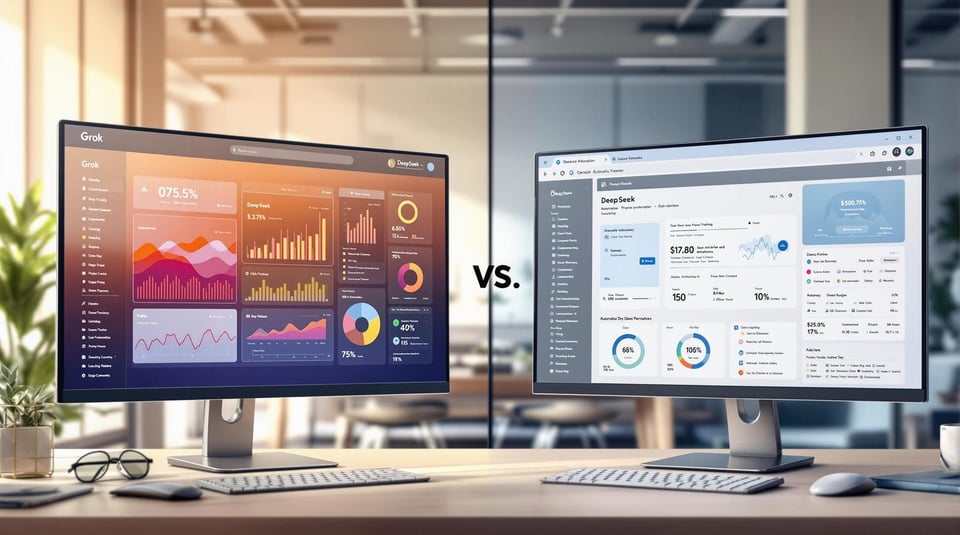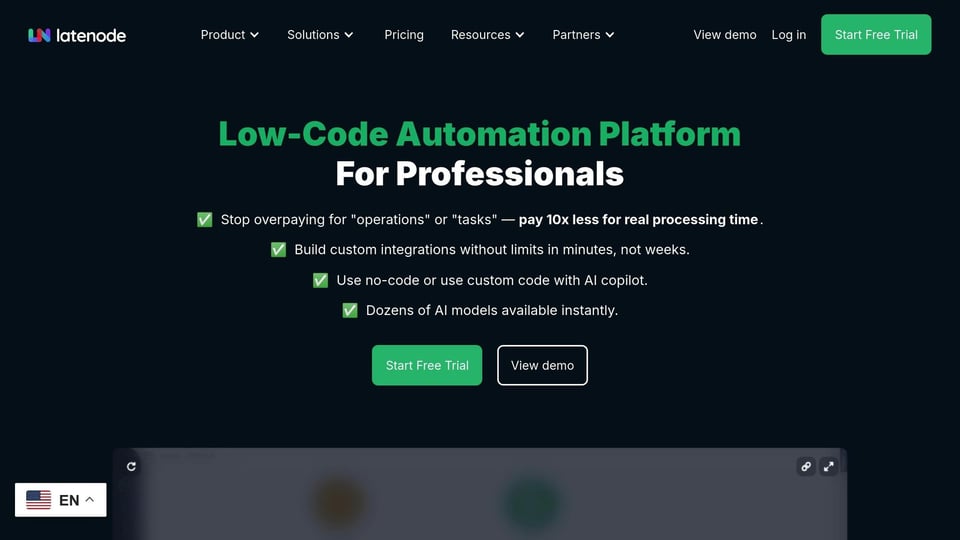



Grok and DeepSeek are two AI-powered platforms designed to automate workflows, but they cater to different needs. Here's a quick breakdown:
Key Takeaway: Choose Grok for high-performance tasks and DeepSeek for budget-friendly, research-focused automation.
Grok and DeepSeek each bring different strengths to the table, tailored to specific business needs and use cases.
Grok focuses on real-time personalization and adaptive learning. Its Deep Search feature provides step-by-step reasoning, while Big Brain Mode handles advanced computational tasks [3]. The platform is especially strong in technical fields like coding, offering tailored content based on user interactions [6].
Using natural language processing and machine learning, Grok interprets user queries and delivers responses that align with the context.
DeepSeek specializes in Knowledge Process Automation (KPA), blending knowledge discovery, intelligent automation, and decision-making tools [4]. Its DataRig system is built for high-value knowledge tasks [4], and it stands out with direct, clickable source links for every claim.
By using agents pre-trained on curated datasets, DeepSeek ensures reliable insights, achieving performance levels of 80% or higher. DeepSeek is a useful tool for text generation, data analysis, information retrieval, and integration into your workflows.
For example, by integrating AI in the free automation template on Latenode, you can automatically generate a unified and detailed news digest. Don’t scroll the websites anymore — Automate news monitoring.
| Feature Category | Grok | DeepSeek |
|---|---|---|
| Code Generation | Excels in complex tasks [3] | Produces clear, structured output |
| Reasoning Capability | Comparable performance [3] | Comparable performance [3] |
| Source Verification | Limited source tracking | Direct, clickable source links [2] |
| Output Speed | Variable performance | 25.3 tokens/s [2] |
| Interface Customization | Built-in adaptive UI | Customizable with DeepStyled extension [8] |
| Knowledge Processing | Focused on computational tasks | Specialized in knowledge automation [4] |
In testing, DeepSeek R1 produced clearer and more structured results in both code generation and logical reasoning tasks. Its ability to provide verifiable outputs gives it an edge, especially for research-focused queries. Next, let's look at how each platform's integration tools enhance workflow automation.
Both platforms expand their automation capabilities with API integration solutions tailored for enterprise workflow automation.
 You can connect your own applications and workflows to Grok's capabilities using its API. Currently, the Grok-2 model is the only version available for developers.
You can connect your own applications and workflows to Grok's capabilities using its API. Currently, the Grok-2 model is the only version available for developers.
This API allows you to programmatically access Grok's features, enabling tasks such as:
To make development easier and faster, Software Development Kits (SDKs) are provided for popular programming languages like Python, JavaScript, and Java, simplifying the integration process.
Security is managed using standard industry practices suitable for enterprise use, typically including API key management and potentially OAuth 2.0 authentication to ensure secure connections.
DeepSeek simplifies integration by maintaining compatibility with OpenAI APIs [10]. This is particularly helpful for teams already using OpenAI SDKs.
"Don't log in to DeepSeek, just don't. It seems to need to prove to us that they're able to secure its services."
– Bradley Shimmin, Analyst at Omdia [12]
However, enterprises should be cautious of security challenges:
| Security Aspect | Impact | Mitigation Strategy |
|---|---|---|
| Data Privacy | Subject to PIPL regulations | Opt for third-party hosting |
| Infrastructure | Performance issues | Use failover systems |
| Authentication | API key vulnerabilities | Rotate and monitor keys regularly |
| Compliance | Chinese jurisdiction concerns | Use AWS or Azure hosting options |
Both platforms also integrate well with external tools like Latenode.
 Latenode enhances these platforms through its low-code automation framework. Features include:
Latenode enhances these platforms through its low-code automation framework. Features include:
For DeepSeek, Latenode enables applications like YouTube transcript summarizers without requiring code [11]. Its built-in database and compatibility with 300+ apps make it a powerful link between AI services and business systems.
"Any enterprise that for any reason considers that it is working with any form of proprietary information, which pretty much every enterprise is, should not be using a tool that automatically feeds that data back to what in the U.S. is considered a hostile nation-state. I would not go anywhere near it."
– Johna Till Johnson, CEO and co-founder of Nemertes [12]
When adopting these integrations, thorough testing and robust security protocols are essential. As Stuart Battersby, CTO at Chatterbox Labs, advises:
"The key that we want to say to organizations, though, is that you have to test this stuff. It doesn't matter which model you use. You can't rely on those things to be safe." [12]
Performance is a key consideration in enterprise workflow automation. Here, we break down the execution speed and reliability of Grok and DeepSeek to see how they measure up.
Grok 3 delivers 1.5 petaflops of processing power - triple that of its predecessor, Grok 2 [13]. Its microservices-based architecture allows horizontal scaling, ensuring low latency and high throughput for enterprise operations [17].
According to OpenRouter metrics, Grok Beta achieves a latency of just 0.29 seconds and processes 59.71 tokens per second [15]. Now, let’s take a closer look at DeepSeek's performance.
DeepSeek offers two models with distinct performance levels. DeepSeek V3 processes 26.3 tokens per second with a latency of 3.92 seconds, while DeepSeek R1 handles 25.5 tokens per second but with a much higher latency of 60.47 seconds [14].
Despite these figures, DeepSeek excels in specific tasks. For instance, it outperforms IBM Watson in SQL generation during HumanEval tests, scoring 73.78% compared to Watson's 45.6% [16].
"Our global network of Data Centers with 99.996% uptime keep your models running 24/7, with round-the-clock support." – Contabo [16]
Here’s a summary of the key performance metrics:
| Performance Metric | Grok 3 | DeepSeek V3 | DeepSeek R1 |
|---|---|---|---|
| Processing Power | 1.5 petaflops | Not disclosed | Not disclosed |
| Output Speed | 59.71 tokens/s | 26.3 tokens/s | 25.5 tokens/s |
| Latency | 0.29 s | 3.92 s | 60.47 s |
| Infrastructure Uptime | Measured under variable network conditions | 99.996% uptime on Contabo servers | 99.996% uptime on Contabo servers |
An evaluation by Analytics Vidhya in February 2025 compared these platforms across tasks like Python code generation, web search, HTML animation, image analysis, and logical reasoning. DeepSeek R1 outperformed in all areas except image analysis [2].
Grok relies on microservices for distributed processing, while DeepSeek utilizes distributed storage and caching systems [17] [18]. Next, we’ll explore how these performance metrics translate into practical uses.
Businesses are tapping into the capabilities of Grok and DeepSeek for a variety of automation tasks, each suited to specific strategic goals and operational needs.
Grok is well-suited for real-time market intelligence and dynamic customer engagement. It’s frequently used by organizations for tasks like rapid competitive analysis and interpreting live sales data streams. Its ability to process real-time data from X makes it a valuable tool for identifying emerging market trends, tracking competitor campaigns, and gauging brand sentiment instantly.
"A unique and fundamental advantage of Grok is that it has real‑time knowledge of the world via the X platform. It will also answer spicy questions that are rejected by most other AI systems." – xAI
In customer service, Grok can analyze support interactions in real-time to identify pressing issues or upsell opportunities. While specific industry benchmarks vary (like its evaluation in healthcare radiology), its core strength lies in immediate data processing.
For small and medium-sized businesses (SMBs), Grok addresses key challenges like lead generation and conversion, which 60% of SMBs cite as a top priority. Its main business applications include:
On the other hand, DeepSeek shines in areas like complex operational analysis and strategic planning support.
DeepSeek is tailored for deep analytical reasoning and solving complex business logic problems.
"The cost of compute is coming down dramatically. The price per token is coming down dramatically. That means these models are becoming cost efficient. It is great for the world that this will be cheaper for all of us." – Kim Posnett, global co‑head of investment banking at Goldman Sachs
In regulated industries like finance or healthcare, DeepSeek has potential to streamline compliance reporting and optimize resource allocation, but implementation requires careful consideration of data privacy and regulatory requirements.
| Application Area | Grok Strengths | DeepSeek Strengths |
| Market Analysis | Real-time trend & competitor monitoring | In-depth historical data & forecast modeling |
| Customer Interaction | Dynamic content personalization & engagement | Analyzing complex customer behavior patterns |
| Process Automation | Seamless integration of Grok 3 with X and public API for Grok 2, but that’s about it for now. | Automate complex internal workflows & reporting by connecting DeepSeek V3 and DeepSeek R1 with over 300 integrations on Latenode |
| Operations | Rapid response based on live operational data | Deep analysis for resource & supply chain optimization |
When deciding between these tools, the choice should depend on the specific business objective and operational context. Grok is ideal for high-speed market responsiveness and customer-facing content tasks, while DeepSeek is better equipped for complex internal analysis, strategic planning, and optimizing back-end operations.
Cost plays a big role when deciding on a low-code workflow automation platform.
You can use Grok for free on X. It also offers pricing through X Premium+ subscription tiers. In the U.S., it costs $30 per month.
For developers and enterprises using API access, Grok follows a pay-as-you-go model: $2 per million input tokens and $10 per million output tokens [29]. New API users also receive $25 in free credits [29].
DeepSeek itself is a free-to-use chatbot. However, it offers two token-based pricing models for API:
DeepSeek-chat:
DeepSeek-reasoner:
| Feature | Grok | DeepSeek |
|---|---|---|
| Basic Access | $40/month (via X Premium+) [26] | Free with Gmail signup [25] |
| API Input Cost | $2 per 1M tokens [29] | $0.07–$0.27 per 1M tokens [24] |
| API Output Cost | $10 per 1M tokens [29] | $1.10–$2.19 per 1M tokens [24] |
| Free Credits | $25 API credits [29] | Available through web platform [25] |
| Enterprise Options | Custom pricing via X | Token-based scaling |
This comparison highlights DeepSeek's lower API costs and free web access, making it an attractive choice for budget-conscious users. For example, processing ~750,000 words (1M tokens) costs just $3 with DeepSeek, compared to $17.10 with traditional alternatives [28].
On the other hand, Grok positions itself as a higher-priced, premium solution, tightly integrated with the X platform, which might appeal to businesses already invested in that ecosystem. It’s currently one of the most expensive AI tools with DeepSearch capabilities [27].
Grok shines when you need real-time data analysis and quick decision-making, making it especially useful for social media analytics.
It works best for:
DeepSeek is a better fit for organizations focused on structured reasoning and cost-effective AI solutions. It stands out in:
These distinctions build on earlier feature and pricing comparisons to help you make the right choice.
| Business Need | Recommended Platform | Key Advantage |
|---|---|---|
| Real-time Analytics | Grok | Live web access & X integration |
| Research Tasks | DeepSeek | Superior reasoning capabilities |
| Budget Constraints | DeepSeek | Lower token costs |
| Content Creation | Grok | Real-time data integration |
To choose the right platform, follow these steps:
Start using Latenode today



